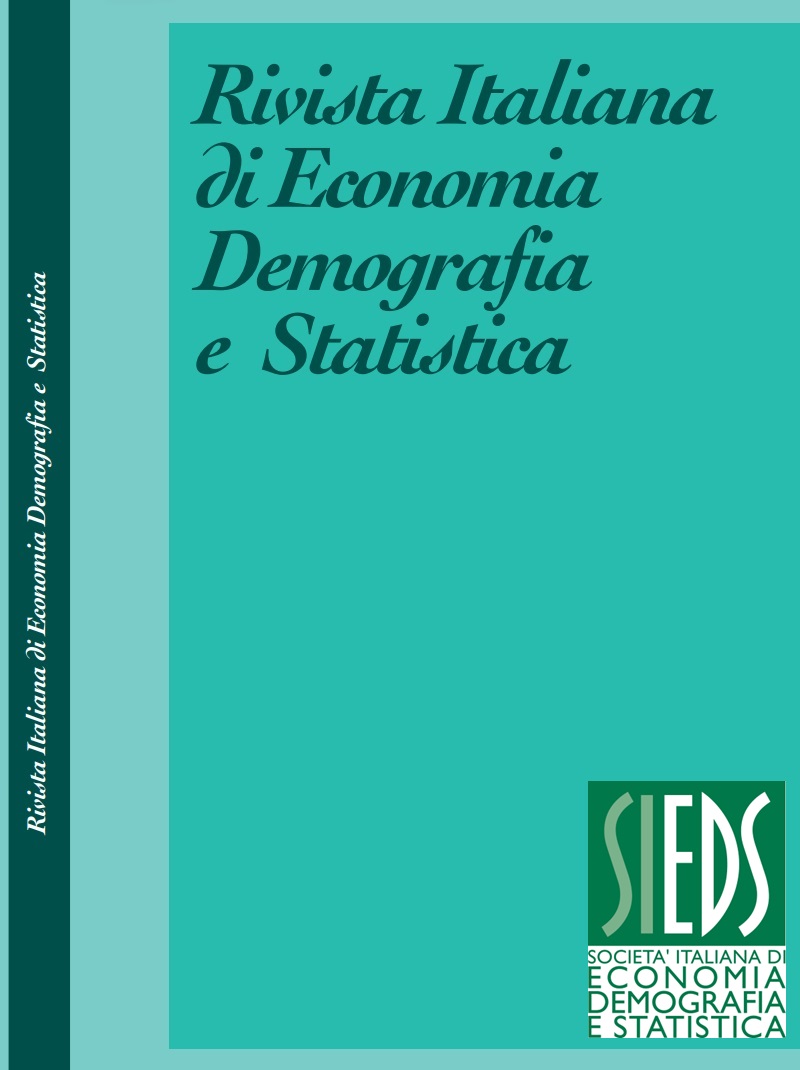Obstetrical health consequences of female genital mutilations/cuttings: evidence from Italian hospital discharge records
DOI:
https://doi.org/10.71014/sieds.v79i3.364Keywords:
female genital mutilation, immigration, healthcare, fgmAbstract
More than 230 million women live with FGM/C worldwide, a condition linked to adverse health consequences, and for which the quality of available health care is often inadequate. As it is hard to identify and reach migrant women with FGM/C living in host countries, the research on this population group in Europe is limited. This paper focuses on the Italian context. The aim is to investigate the probability for immigrants coming from countries where FGM/C is practiced to be hospitalised for FGM/C-related obstetrical issues, using data from Italian Hospital Discharge Records for the year 2019. Results show that an increase of 1 percent point in the home country FGM/C prevalence is correlated with an increase of 0.43% in the probability of being hospitalised for an FGM/C-related obstetrical condition. Further research should aim at differentiating between the FGM/C types, with a focus on the most harmful practices, i.e. infibulation, and at investigating other potential health consequences, such as physical, sexual and psychological conditions.
References
ABDALLA S. M., GALEA S. 2019. Is female genital mutilation/cutting associated with adverse mental health consequences? A systematic review of the evidence, BMJ Global Health, Vol. 4, No. 4, pp. e001553. DOI: https://doi.org/10.1136/bmjgh-2019-001553
BERG R. C., DENISON E. M.-L., FRETHEIM A. 2010a. Factors promoting and hindering the practice of female genital mutilation/cutting (FGM/C). Knowledge Centre for the Health Services at The Norwegian Institute of Public Health (NIPH).
BERG R. C., DENISON E. M.-L., FRETHEIM A. 2010b. Psychological, social and sexual consequences of female genital mutilation/cutting (FGM/C): a systematic review of quantitative studies. Knowledge Centre for the Health Services at The Norwegian Institute of Public Health (NIPH).
BERG R. C., UNDERLAND V., ODGAARD-JENSEN J., FRETHEIM A., VIST G. E. 2014. Effects of female genital cutting on physical health outcomes: A systematic review and meta-analysis. BMJ Open, Vol. 4, No. 11, pp. e006316. DOI: https://doi.org/10.1136/bmjopen-2014-006316
CAROPPO E., ALMADORI A., GIANNUZZI V., BROGNA P., DIODATI A., BRIA P. 2014. Health care for immigrant women in Italy: are we really ready? A survey on knowledge about female genital mutilation, Annali dell’Istituto Superiore di Sanità, Vol. 50, pp. 49-53.
CHIBBER R., El-SALEH E., EL HARMI J. 2011. Female circumcision: obstetrical and psychological sequelae continues unabated in the 21st century. The Journal of Maternal-Fetal & Neonatal Medicine, Vol. 24, No. 6, pp. 833-836. DOI: https://doi.org/10.3109/14767058.2010.531318
COTTLER-CASANOVA S., HOROWICZ M., GIESZL S., JOHNSON-AGBAKWU C., ABDULCADIR J. 2020. Coding female genital mutilation/cutting and its complications using the International Classification of Diseases: a commentary. BJOG: An International Journal of Obstetrics & Gynaecology, Vol. 127, No. 6, pp. 660-664. DOI: https://doi.org/10.1111/1471-0528.16086
EVANS C., TWEHEYO R., MCGARRY J., ELDRIDGE J., ALBERT J., NKOYO V., HIGGINBOTTOM G. 2019a. Crossing cultural divides: a qualitative systematic review of factors influencing the provision of healthcare related to female genital mutilation from the perspective of health professionals, PloS one, Vol. 14, No. 3, pp. e0211829. DOI: https://doi.org/10.1371/journal.pone.0211829
EVANS C., TWEHEYO R., MCGARRY J., ELDRIDGE J., ALBERT J., NKOYO V., HIGGINBOTTOM G. M. A. 2019b. Seeking culturally safe care: a qualitative systematic review of the healthcare experiences of women and girls who have undergone female genital mutilation/cutting, BMJ Open, Vol. 9, No. 5, pp. e027452. DOI: https://doi.org/10.1136/bmjopen-2018-027452
FARINA P., ORTENSI L. E., MENONNA A. 2016. Estimating the number of foreign women with female genital mutilation/cutting in Italy, The European Journal of Public Health, Vol. 26, No. 4, pp. 656-661. DOI: https://doi.org/10.1093/eurpub/ckw015
FERNANDEZ R. 2011. Chapter 11: Does culture matter? In BENHABIB J. and BISIN A. JACKSON M.O. (Eds.) Handbook of Social Economics, North-Holland, Vol. 1, pp. 481-510.
O’NEILL S., PALLITTO C. 2021. The Consequences of Female Genital Mutilation on Psycho-Social Well-Being: A Systematic Review of Qualitative Research, Qualitative Health Research, Vol. 31, No. 9, pp. 1738-1750. DOI: https://doi.org/10.1177/10497323211001862
ORTENSI L. E., FARINA P., LEYE E. 2018. Female genital mutilation/cutting in Italy: an enhanced estimation for first generation migrant women based on 2016 survey data, BMC Public Health, Vol. 18, No. 1, pp. 1-10. DOI: https://doi.org/10.1186/s12889-017-5000-6
ORTENSI L. E., FARINA P., MENONNA A. 2015. Improving estimates of the prevalence of Female Genital Mutilation/Cutting among migrants in Western countries, Demographic Research, Vol. 32, No. 18, pp 543-562. DOI: https://doi.org/10.4054/DemRes.2015.32.18
REISEL D., CREIGHTON S.M. 2015. Long term health consequences of Female Genital Mutilation (FGM), Maturitas, Vol. 80, No. 1, pp. 48-51. DOI: https://doi.org/10.1016/j.maturitas.2014.10.009
REYNERS M. 2004. Health consequences of female genital mutilation, Reviews in Gynaecological Practice, Vol. 4, No. 4, pp. 242-251. DOI: https://doi.org/10.1016/j.rigp.2004.06.001
SURICO D., AMADORI R., GASTALDO L., TINELLI R., SURICO N. 2015. Female genital cutting: A survey among healthcare professionals in Italy, Journal of Obstetrics and Gynaecology, Vol. 35, No. 4, pp. 393-396. DOI: https://doi.org/10.3109/01443615.2014.960826
TURILLAZZI E., FINESCHI V. 2007. Female genital mutilation: the ethical impact of the new Italian law, Journal of Medical Ethics, Vol. 33, No. 2, pp. 98-101. DOI: https://doi.org/10.1136/jme.2006.016154
TURKMANI S., HOMER C. S., DAWSON A. 2018. Maternity care experiences and health needs of migrant women from female genital mutilation–practicing countries in high-income contexts: A systematic review and meta-synthesis, Birth, Vol. 46, No. 1, pp. 3-14. DOI: https://doi.org/10.1111/birt.12367
UNITED NATIONS CHILDREN’S FUND. 2024. Female Genital Mutilation: A global concern. 2024 Update. UNICEF, New York.
VAN BAELEN L., ORTENSI L., LEYE E. 2016. Estimates of first-generation women and girls with female genital mutilation in the European Union, Norway and Switzerland, The European Journal of Contraception & Reproductive Health Care, Vol. 21, No. 6, pp. 474-482. DOI: https://doi.org/10.1080/13625187.2016.1234597
WORLD HEALTH ORGANIZATION. 2018. Care of women and girls living with female genital mutilation: a clinical handbook. WHO.
Downloads
Published
Issue
Section
License
Copyright (c) 2025 Chiara Allegri, Helen Banks

This work is licensed under a Creative Commons Attribution 4.0 International License.



